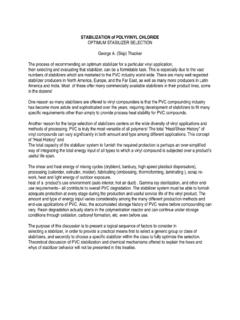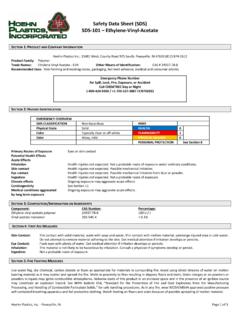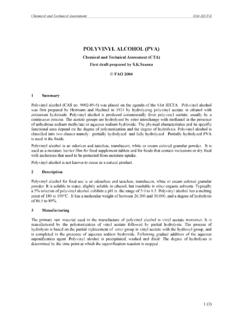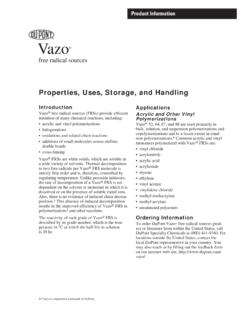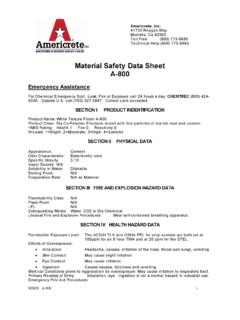Transcription of 10 Vinyl Acetate Monomer Process - Chemical Engineering
1 287. 10. Vinyl Acetate Monomer Process Basis of Design The Vinyl Acetate Monomer (VAM) is large-scale commodity Chemical mostly used in manufacturing polyvinyl Acetate , the basic ingredient in water-soluble acrylic paints. Other applications are coatings for textile and paper industries, laminated safety glass, packaging, automotive fuel tanks and acrylic bers. The worldwide production of Vinyl Acetate was about 5 million tonnes per year in 2005, with rapid growth in the emerging markets. Higher ef ciency can be achieved by upstream integration with the production of low-cost acetic acid, as well as by downstream integration with the manufacturing of polyvinyl Acetate and polyvinyl alcohol. Manufacturing Routes Three main routes for Vinyl Acetate manufacturing are employed today, as follows [1, 2]: 1.
2 Acetic acid and acetylene The Process is based on the reaction: HC CH + CH3 COOH H2C = CH-O-(CO)CH3 with H = 118 KJ/mol The operating conditions are gas phase at 170 250 C and Zn(OAc)2 catalyst impregnated on charcoal. Per-pass acetylene conversion is 60 70% with a selec- tivity of 93% acetylene and 99% acetic acid. High acetylene cost and safety problems make this Process less competitive today. 2. Acetaldehyde and acetic anhydride The Process takes place in two stages. Firstly acetaldehyde and acetic anhydride form ethylidene diacetate in liquid phase at 120 140 C with FeCl3 as a catalyst: CH3 CHO + (CH3CO)2 O CH3CH(OCOCH3 )2. Chemical Process Design: Computer-Aided Case Studies. Alexandre C. Dimian and Costin Sorin Bildea Copyright 2008 WILEY-VCH Verlag GmbH & Co.
3 KGaA, Weinheim ISBN: 978-3-527-31403-4. 288 10 Vinyl Acetate Monomer Process In the second step the intermediate decomposes at 120 C with acid catalyst: CH3CH(OCOCH3 )2 H2C = CH-O-(CO)CH3 + CH3 COOH. Note that this Process may rely completely on renewable raw materials. 3. Acetic acid, ethylene and oxygen This route dominates today and it will be adopted in this project. In older tech- nologies the reaction was conducted in liquid phase at 110 130 C and 30 40. bar in the presence of a redox catalyst PdCl2/CuCl2, but corrosion raised prob- lems. Modern processes operate in gas phase with Pd-based catalysts. A highly undesired secondary reaction is the combustion of ethylene to CO2. With modern Pd/Au catalysts the selectivity may reach 94%, based on ethylene and 98 99% based on acetic acid.
4 The removal of CO2 usually by a wash with hot KOH solution negatively affects the overall economics. Hoechst/Celanese and Bayer/DuPont are the most widespread processes, the main difference being in the formulation of the catalyst. With respect to reaction Engineering a mul- titubular xed-bed reactor is employed, where the operational dif culty is mastering the occurrence of excessive temperature rise (hot spot). Recently, uid-bed reactor technology was developed with better productivity and 30%. lower investment [13]. Searching for low-cost acetic acid sources is important since this takes about 70 wt% in the end product. From this viewpoint two processes developed by the Halcon Company can be mentioned [2]: 1.
5 Integration of Vinyl Acetate and ethylene glycol manufacturing through the intermediate 1,2-diacetoxyethane. 2. Hydrogenative carbonylation of methyl Acetate to 1,1-diacetoxyethane followed by cleavage to Vinyl Acetate and acetic acid. Only syngas is involved as raw materials. Problem Statement The project deals with a VAM plant capacity of 100 kton per year for an effective operation time of 8400 h. The Process will be based on the acetoxylation of ethylene conducted in gas phase in the presence of a palladium-based solid catalyst. The case study will tackle the problem of Process synthesis and energy integration, as well as the dynamics and control for ensuring exibility in production rate of 10%, while preserving safety and environment protection.
6 Table presents typical speci cations for a polymerization-grade product, as well as some physical properties. Prohibited impurities refer to inhibitors (croton- aldehyde, Vinyl acetylene), chain-transfer agents (acetic acid, acetaldehyde, acetone). and polymerizable species ( Vinyl crotonate), while methyl and ethyl Acetate impuri- ties are tolerated. Reactions and Thermodynamics 289. Table Properties for industrial Vinyl Acetate [1]. Property Value Molecular weight Vinyl ester content Distillation range ( kPa) 72 73 C. Freezing point 93 C. Water Max. 400 ppm Acid content (acetic acid) Max 50 ppm Acetaldehyde Max 100 ppm Inhibitor content 3 5 ppm nD20 d2020 Liquid viscosity at 20 C cP. Solubility VAM-water/water-VAM at 25 C Solubility in organic solvents complete Upper/lower explosion limit vapor in air at 20 C vol.
7 Health and Safety Vinyl Acetate is slightly or moderately toxic to humans and animals. The vapor irritates the eyes starting with 20 ppm, while the detection threshold is reported to be about ppm. Released into the environment the Vinyl Acetate evaporates easily, being degraded rapidly by photochemical reactions, as well as biodegraded by either anaerobic or aerobic mechanisms. Therefore, the bioaccumulation of Vinyl Acetate in the ecosphere is unlikely. Vinyl Acetate is dangerous when exposed to heat, ame or oxidizers, and as a consequence, it requires adhering to the safety measures when stored or manipu- lated by operators. The same precaution is valid for the raw materials. Ethylene is highly explosive in mixture with oxygen, the explosion limit being at 10% vol.
8 The acetic acid is a highly toxic and corrosive substance. Stainless steel of Cr/Ni/Co type is employed for operations involving acetic-acid solutions in boiling condi- tions, but normal stainless steel may be used for vapor-phase operations. Reactions and Thermodynamics Reaction Kinetics The manufacturing of Vinyl Acetate by the oxyacetylation of ethylene is described by the following stoichiometric reaction: 290 10 Vinyl Acetate Monomer Process C2H4 + CH3 COOH + C2H3 OOCCH3 + H2O ( ). Gas-phase reaction is preferred because of better yield and less corrosion problems. The combustion of ethylene to CO2 is a highly undesired secondary reaction since it lowers the yield and complicates the removal of the reaction heat: C2H4 + 3O2 2CO2 + 2H2O ( ).
9 Note that the standard heat of reaction is of and kcal/kJ per mol for Vinyl Acetate and ethylene combustion, respectively. If both reactions are considered the mean exothermal effect may be estimated at about 250 kJ/mol [1]. The catalyst plays a crucial role in technology. Previously, catalysts were based on palladium of 1 to 5 wt% impregnated on silica with alkali metal acetates as activators. Modern catalysts employ as enhancers noble metals, mostly gold. A. typical Bayer-type catalyst consists of wt% Pd, wt% Au, 4 10 wt%. KOAc on spherical silica particles of 5 mm diameter [14]. The reaction is very fast and takes place mainly inside a thin layer on the particle surface (egg-shell catalyst). Typical catalyst lifetime is 1 2 years.
10 Preferred operation conditions are tem- peratures around 150 to 160 C and pressures 8 to 10 bar. Hot spots above 200 C. lead to permanent catalyst deactivation. The reactant ratio should ensure an excess of ethylene to acetic acid of about 2 : 1 to 3 : 1. Due to an explosion danger the oxygen concentration in the reaction mixture should be kept below 8%, based on an acetic-acid-free mixture [1]. The above gures formulate design constraints in the present project. In addition, a small amount of water in the initial mixture could be necessary for catalyst activation. Because of the highly exothermic effect, measures to moderate the temperature increase are necessary, such as the dilution of the reaction mixture with some inert gas.


